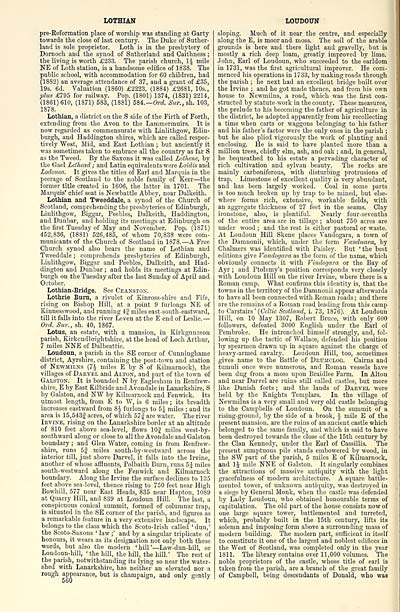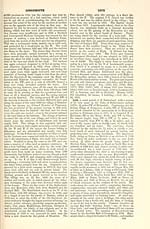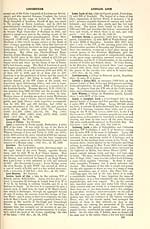Ordnance gazetteer of Scotland > Volume 5
(80) Page 560
Download files
Complete book:
Individual page:
Thumbnail gallery: Grid view | List view

LOTHIAN
pre-Reformation place of worship was standing at Garty
towards the close of last century. The Duke of Suther-
land is sole proprietor. Loth is in the presbytery of
Dornoch and the synod of Sutherland and Caithness ;
the living is worth £233. The parish church, I4 mile
NE of Loth station, is a handsome edifice of 1838. The
public school, with accommodation for 60 children, had
(1882) an average attendance of 37, and a grant of £35,
19s. 6d. Valuation (1860) £2223, (1884) £2681, 10s.,
plus £1^0 for railway. Pop. (1801) 1374, (1831) 2214,
(1861) 610, (1871) 583, (1881) 584.— Orrf. Sur., sh. 103,
1878.
Lothian, a district on the S side of the Firth of Forth,
extending from the Avon to the Lammermuirs. It is
now regarded as commensurate with Linlithgow, Edin-
burgh, and Haddington shires, which are called respec-
tively West, Mid, and East Lothian ; but anciently it
was sometimes taken to embrace all the country as far S
as the Tweed. By the Saxons it was called Lotlieiie, by
the Gael Lethead ; and Latin equivalents were Loidis and
Lodonea. It gives the titles of Earl and Marquis in the
peerage of Scotland to the noble family of Kerr — the
former title created in 1606, the latter in 1701. The
Marquis' chief seat is Newbattle Abbey, near Dalkeith.
Lothian and Tweeddale, a synod of the Church of
Scotland, comprehending the presbyteries of Edinburgh,
Linlithgow, Biggar, Peebles, Dalkeith, Haddington,
and Dunbar, and holding its meetings at Edinburgh on
the first Tuesday of May and November. Pop. (1871)
452,836, (1881) 526,485, of whom 70,838 were com-
municants of the Church of Scotland in 1878. — A Free
Church synod also bears the name of Lothian and
Tweeddale ; comprehends presbyteries of Edinburgh,
Linlithgow, Biggar and Peebles, Dalkeith, and Had-
dington and Dunbar ; and holds its meetings at Edin-
burgh on the Tuesday after the last Sunday of April and
October.
Lothian-Bridge. See CE.iNSTON'.
Lothrie Bum, a rivulet of Kinross-shire and Fife,
rising on Bishop Hill, at a point 9 furlongs NE of
Kinuesswood, and running 4s miles east-south-eastward,
till it falls into the river Leven at the E end of Leslie. —
Ord. Su7\, sh. 40, 1867.
Lotus, an estate, ^vith a mansion, in Kirkgunzeon
parish, Kirkcudbrightshire, at the head of Loch Arthur,
7 miles NNE of Dalbeattie.
Loudoun, a parish in the SE corner of Cunninghame
district, Ayrshire, containing the post-town and station
of Newmilns (74 miles E'by S of Kilmarnock), the
villages of Dakvel and Alton, and part of the town of
Galston. It is bounded N by Eaglesham in Renfrew-
shire, E by East Kilbride and Avondale in Lanarkshire, S
by Galston, and NW by Kilmarnock and Fenwick. Its
utmost length, from E to ^Y, is 6 miles ; its breadth
increases eastward from 8 J furlongs to 5| miles ; and its
area is 15,543| acres, of which 57J are water. The river
Ikvine, rising on the Lanarkshire border at an altitude
of 810 feet above sea-level, flows 10| miles west-by-
southward along or close to all the Avondale and Galston
boundary ; and Glen Water, coming in from Renfrew-
shire, runs 5J miles south-b}'-westward across the
interior till, just above Darvel, it falls into the Irvine,
another of whose aflluents, Polbaith Burn, runs 5 J miles
south-westward along the Fenwick and Kilmarnock
boundary. Along the Irvine the surface declines to 135
feet above sea-level, thence rising to 750 feet near High
Bowhill, 577 near East Heads, 835 near Hapten, 1089
at Quarry Hill, and 839 at Loudoun Hill. The last, a
conspicuous conical summit, formed of columnar trap,
is situated in the SE corner of the parisli, and figures as
a remarkable feature in a very extensive landscape. It
belongs to the class which the Scoto-Irish called 'dun,'
the Scoto-Saxons ' law ;' and by a singular triplicate of
honours, it wears as its designation not only both these
■words, but also the modern ' hill '—Law-dun-hill, or
Loudoun-hill, 'the hill, tlie hill, the hill.' The rest of
the parish, notwithstanding its lying so near the water-
shed with Lanarkshire, has neither an elevated nor a
rough appearance, but is champaign, and only gently
LOUDOUN
sloping. Much of it near the centre, and especially
along the E, is moor and moss. The soil of the arable
grounds is here and there light and gravelly, but is
mostly a rich deep loam, greatly improved by lime.
John, Earl of Loudoun, who succeeded to the earldom
in 1731, was the first agricultural improver. He com-
menced his operations in 1733, by making roads through
the parish ; he next had an excellent bridge built over
the Irvine ; and he got made thence, and from his own
house to Newmilns, a road, which was the first con-
structed by statute-work in the county. These measures,
the prelude to his becoming the father of agriculture in
the district, he adopted apparently from his recollecting
a time when carts or waggons belonging to his father
and his father's factor were the only ones in the parish ;
but he also plied vigorously the work of planting and
enclosing. He is said to have planted more than a
million trees, chiefly elm, ash, and oak ; and, in general,
he bequeathed to his estate a pervading character of
rich cultivation and sylvan beauty. The rocks are
mainly carboniferous, with disturbing protrusions of
trap. Limestone of excellent quality is very abundant,
and has been largely worked. Coal in some parts
is too much broken up by trap to be mined, but else-
where forms rich, extensive, workable fields, with
an aggregate thickness of 27 feet in the seams. Clay
ironstone, also, is plentiful. Nearly four-sevenths
of the entire area are in tillage ; about 750 acres are
under wood ; and the rest is either pastoral or waste.
At Loudoun Hill Skene places Vandogara, a town of
the Damnonii, which, under the form Vanduara, by
Chalmers was identified with Paisley. But ' the best
editions give Vandogara as the form of the name, which
obviously connects it with Vindogara or the Bay of
Ayr ; and Ptolemy's position coiTesponds very closely
with Loudoun Hill on the river Irvine, where there is a
Roman camp. What confirms this identity is, that the
towns in the territory of the Damnonii appear afterwards
to have all been connected with Roman roads ; and there
are the remains of a Roman road leading from this camp
to Carstairs ' (Celtic Scotland, i. 73, 1876). At Loudoun
Hill, on 10 May 1307, Robert Bruce, with only 600
followers, defeated 3000 English under the Earl of
Pembroke. He intrenched himself strongly, and, fol-
lowing up the tactic of Wallace, defended his position
by spearmen drawn up in square against the charge of
heavy-armed cavalry. Loudoun Hill, too, sometimes
gives name to the Battle of Deumclog. Cairns and
tumuli once were numerous, and Roman vessels have
been dug from a moss upon Braidlee Farm. In Alton
and near Darvel are ruins still called castles, but more
like Danish forts ; and the lands of Darvel were
held by the Knights Templars. In the village of
Newmilns is a very small and very old castle belonging
to the Campbells of Loudoun. On the summit of a
rising-ground, by the side of a brook, J mile E of the
present mansion, are the ruins of an ancient castle which
belonged to the same family, and which is said to have
been destroyed towards the close of the 15th century by
the Clan Kennedy, under the Earl of Cassillis. The
present sumptuous pile stands embowered by wood, in
the SW part of the parish, 5 miles E of Kilmarnock,
and 14 mile NNE of Galston. It singularly combines
the attractions of massive antiquity with the light
gracefulness of modern architecture. A square battle-
mented tower, of unknown antiquity, was destroyed in
a siege by General Monk, when the castle was defended
by Lady Loudoun, who obtained honourable terms of
capitulation. The old part of the house consists now of
one large square tower, battlemented and turreted,
which, probably built in the 15th century, lifts its
solemn and imposing form above a surrounding mass of
modern building. The modern part, sufficient in itself
to constitute it one of the largest and noblest edifices in
the AVest of Scotland, was completed only in the year
1811. The library contains over 11,000 volumes. The
noble proprietors of the castle, whose title of earl is
taken from the parish, are a branch of the great family
of Campbell, being descendants of Donald, who was
pre-Reformation place of worship was standing at Garty
towards the close of last century. The Duke of Suther-
land is sole proprietor. Loth is in the presbytery of
Dornoch and the synod of Sutherland and Caithness ;
the living is worth £233. The parish church, I4 mile
NE of Loth station, is a handsome edifice of 1838. The
public school, with accommodation for 60 children, had
(1882) an average attendance of 37, and a grant of £35,
19s. 6d. Valuation (1860) £2223, (1884) £2681, 10s.,
plus £1^0 for railway. Pop. (1801) 1374, (1831) 2214,
(1861) 610, (1871) 583, (1881) 584.— Orrf. Sur., sh. 103,
1878.
Lothian, a district on the S side of the Firth of Forth,
extending from the Avon to the Lammermuirs. It is
now regarded as commensurate with Linlithgow, Edin-
burgh, and Haddington shires, which are called respec-
tively West, Mid, and East Lothian ; but anciently it
was sometimes taken to embrace all the country as far S
as the Tweed. By the Saxons it was called Lotlieiie, by
the Gael Lethead ; and Latin equivalents were Loidis and
Lodonea. It gives the titles of Earl and Marquis in the
peerage of Scotland to the noble family of Kerr — the
former title created in 1606, the latter in 1701. The
Marquis' chief seat is Newbattle Abbey, near Dalkeith.
Lothian and Tweeddale, a synod of the Church of
Scotland, comprehending the presbyteries of Edinburgh,
Linlithgow, Biggar, Peebles, Dalkeith, Haddington,
and Dunbar, and holding its meetings at Edinburgh on
the first Tuesday of May and November. Pop. (1871)
452,836, (1881) 526,485, of whom 70,838 were com-
municants of the Church of Scotland in 1878. — A Free
Church synod also bears the name of Lothian and
Tweeddale ; comprehends presbyteries of Edinburgh,
Linlithgow, Biggar and Peebles, Dalkeith, and Had-
dington and Dunbar ; and holds its meetings at Edin-
burgh on the Tuesday after the last Sunday of April and
October.
Lothian-Bridge. See CE.iNSTON'.
Lothrie Bum, a rivulet of Kinross-shire and Fife,
rising on Bishop Hill, at a point 9 furlongs NE of
Kinuesswood, and running 4s miles east-south-eastward,
till it falls into the river Leven at the E end of Leslie. —
Ord. Su7\, sh. 40, 1867.
Lotus, an estate, ^vith a mansion, in Kirkgunzeon
parish, Kirkcudbrightshire, at the head of Loch Arthur,
7 miles NNE of Dalbeattie.
Loudoun, a parish in the SE corner of Cunninghame
district, Ayrshire, containing the post-town and station
of Newmilns (74 miles E'by S of Kilmarnock), the
villages of Dakvel and Alton, and part of the town of
Galston. It is bounded N by Eaglesham in Renfrew-
shire, E by East Kilbride and Avondale in Lanarkshire, S
by Galston, and NW by Kilmarnock and Fenwick. Its
utmost length, from E to ^Y, is 6 miles ; its breadth
increases eastward from 8 J furlongs to 5| miles ; and its
area is 15,543| acres, of which 57J are water. The river
Ikvine, rising on the Lanarkshire border at an altitude
of 810 feet above sea-level, flows 10| miles west-by-
southward along or close to all the Avondale and Galston
boundary ; and Glen Water, coming in from Renfrew-
shire, runs 5J miles south-b}'-westward across the
interior till, just above Darvel, it falls into the Irvine,
another of whose aflluents, Polbaith Burn, runs 5 J miles
south-westward along the Fenwick and Kilmarnock
boundary. Along the Irvine the surface declines to 135
feet above sea-level, thence rising to 750 feet near High
Bowhill, 577 near East Heads, 835 near Hapten, 1089
at Quarry Hill, and 839 at Loudoun Hill. The last, a
conspicuous conical summit, formed of columnar trap,
is situated in the SE corner of the parisli, and figures as
a remarkable feature in a very extensive landscape. It
belongs to the class which the Scoto-Irish called 'dun,'
the Scoto-Saxons ' law ;' and by a singular triplicate of
honours, it wears as its designation not only both these
■words, but also the modern ' hill '—Law-dun-hill, or
Loudoun-hill, 'the hill, tlie hill, the hill.' The rest of
the parish, notwithstanding its lying so near the water-
shed with Lanarkshire, has neither an elevated nor a
rough appearance, but is champaign, and only gently
LOUDOUN
sloping. Much of it near the centre, and especially
along the E, is moor and moss. The soil of the arable
grounds is here and there light and gravelly, but is
mostly a rich deep loam, greatly improved by lime.
John, Earl of Loudoun, who succeeded to the earldom
in 1731, was the first agricultural improver. He com-
menced his operations in 1733, by making roads through
the parish ; he next had an excellent bridge built over
the Irvine ; and he got made thence, and from his own
house to Newmilns, a road, which was the first con-
structed by statute-work in the county. These measures,
the prelude to his becoming the father of agriculture in
the district, he adopted apparently from his recollecting
a time when carts or waggons belonging to his father
and his father's factor were the only ones in the parish ;
but he also plied vigorously the work of planting and
enclosing. He is said to have planted more than a
million trees, chiefly elm, ash, and oak ; and, in general,
he bequeathed to his estate a pervading character of
rich cultivation and sylvan beauty. The rocks are
mainly carboniferous, with disturbing protrusions of
trap. Limestone of excellent quality is very abundant,
and has been largely worked. Coal in some parts
is too much broken up by trap to be mined, but else-
where forms rich, extensive, workable fields, with
an aggregate thickness of 27 feet in the seams. Clay
ironstone, also, is plentiful. Nearly four-sevenths
of the entire area are in tillage ; about 750 acres are
under wood ; and the rest is either pastoral or waste.
At Loudoun Hill Skene places Vandogara, a town of
the Damnonii, which, under the form Vanduara, by
Chalmers was identified with Paisley. But ' the best
editions give Vandogara as the form of the name, which
obviously connects it with Vindogara or the Bay of
Ayr ; and Ptolemy's position coiTesponds very closely
with Loudoun Hill on the river Irvine, where there is a
Roman camp. What confirms this identity is, that the
towns in the territory of the Damnonii appear afterwards
to have all been connected with Roman roads ; and there
are the remains of a Roman road leading from this camp
to Carstairs ' (Celtic Scotland, i. 73, 1876). At Loudoun
Hill, on 10 May 1307, Robert Bruce, with only 600
followers, defeated 3000 English under the Earl of
Pembroke. He intrenched himself strongly, and, fol-
lowing up the tactic of Wallace, defended his position
by spearmen drawn up in square against the charge of
heavy-armed cavalry. Loudoun Hill, too, sometimes
gives name to the Battle of Deumclog. Cairns and
tumuli once were numerous, and Roman vessels have
been dug from a moss upon Braidlee Farm. In Alton
and near Darvel are ruins still called castles, but more
like Danish forts ; and the lands of Darvel were
held by the Knights Templars. In the village of
Newmilns is a very small and very old castle belonging
to the Campbells of Loudoun. On the summit of a
rising-ground, by the side of a brook, J mile E of the
present mansion, are the ruins of an ancient castle which
belonged to the same family, and which is said to have
been destroyed towards the close of the 15th century by
the Clan Kennedy, under the Earl of Cassillis. The
present sumptuous pile stands embowered by wood, in
the SW part of the parish, 5 miles E of Kilmarnock,
and 14 mile NNE of Galston. It singularly combines
the attractions of massive antiquity with the light
gracefulness of modern architecture. A square battle-
mented tower, of unknown antiquity, was destroyed in
a siege by General Monk, when the castle was defended
by Lady Loudoun, who obtained honourable terms of
capitulation. The old part of the house consists now of
one large square tower, battlemented and turreted,
which, probably built in the 15th century, lifts its
solemn and imposing form above a surrounding mass of
modern building. The modern part, sufficient in itself
to constitute it one of the largest and noblest edifices in
the AVest of Scotland, was completed only in the year
1811. The library contains over 11,000 volumes. The
noble proprietors of the castle, whose title of earl is
taken from the parish, are a branch of the great family
of Campbell, being descendants of Donald, who was
Set display mode to: Large image | Transcription
Images and transcriptions on this page, including medium image downloads, may be used under the Creative Commons Attribution 4.0 International Licence unless otherwise stated. ![]()
| Gazetteers of Scotland, 1803-1901 > Ordnance gazetteer of Scotland > Volume 5 > (80) Page 560 |
|---|
| Permanent URL | https://digital.nls.uk/97384910 |
|---|
| Attribution and copyright: |
|
|---|---|

